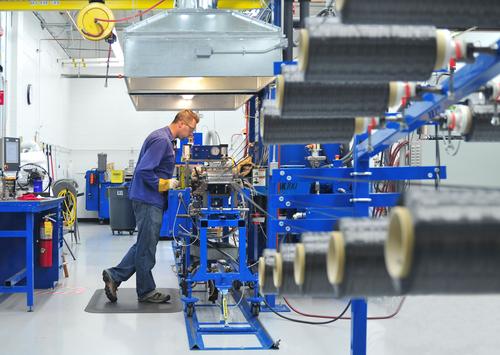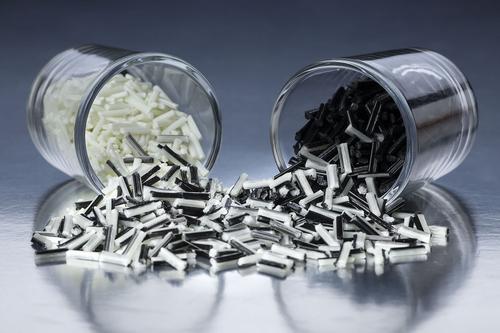Some carbon composite processes are moving into volume auto manufacturing, while intensive R&D is being conducted on many fronts to fast-track material and process development.
September 21, 2016
The past year has seen a lot of technology breakthroughs in engineering composites, especially those aimed at lowering cost and boosting processing speed of carbon composites for volume manufacturing, while maintaining quality. Although some of these breakthroughs are improvements for aerospace and industrial applications, many of the improved processes and materials were aimed at high-volume automotive manufacturing of production cars.
Reinforcing composites with carbon fiber has several well-known benefits, the biggest being unequalled high strength-to-weight ratios. But the high cost of manufacturing carbon fiber, not to mention the cost of most composite manufacturing methods, can be prohibitive for many industries outside of aerospace and high-end sports cars.
New Technologies for Specific Car Platforms
The steep rise in demand for high-performance composites since 2010, driven by aerospace, is slowing, according to a new report from market analyst firm Freedonia Group. Growth will continue in aerospace, which will remain as the leading application area, but at a slower rate, while growth will pick up in wind energy and pressure vessels, such as gas storage containers. Automotive applications will also see strong gains, but broader acceptance is still years away. Carbon fiber composites will continue to dominate demand, rising to 85% by 2020.

For the hood on BMW's M4 GTS, the car company chose Solvay's new MTR 760 rapid-cure, structural, thermoset filament winding resin system for carbon fiber reinforced plastic. (Source: Solvay)
Cars as well as planes are both at the forefront of carbon composite R&D, much of it aimed at implementing composites in volume manufacturing. In luxury, sport, and super cars, new technologies give a glimpse of what may be appearing a few years out in more pedestrian production cars.
BMW's 7-Series luxury cars, for example, will incorporate an EPIKOTE epoxy resin system from Hexion for volume production of structural carbon fiber composite parts in the roof cross-members, center tunnel, and sills. Hexion developed the system to meet BMW's performance and production speed needs in liquid compression molding and high-pressure resin transfer molding (HP RTM). It cures in under two minutes for fast, cost-efficient part production, and the part reduces the car's weight by 130 kg (287 lb) compared to its predecessor.
Lamborghini, a very early adopter of carbon composites for vehicles, has said it is moving away from autoclave-produced composites altogether in favor of chopped-fiber carbon composite sheet molding compound. That goes for structural body-in-white uses as well as non-structural parts. The car maker is also developing its own in-house technologies for composites production. This includes work on an EU project aimed at a much lower-cost process -- estimated at 50% or more -- for making polyethylene-based carbon fiber.
A BASF technology demonstrator for making hollow components with an HP RTM composite process won a JEC World Innovation award this spring. The demonstrator showed how complex hollow components -- mountain bike handlebars -- can be produced for high-volume manufacturing at competitive costs. It used BASF's Elastolit R polyurethane reactive resin, which has very good fatigue strength and high damage tolerance, as well as a wide processing window at short demolding times.

Solvay developed this composite hood for BMW's M4 GTS to meet the car company's specific technical and commercial requirements for cycle time and performance. The MTR 760 rapid-cure, structural, thermoset filament winding resin system has a cure time under five minutes, even faster at higher temperatures. It has superior toughness and a high-quality surface finish for receiving a Class-A paint finish. (Source: Solvay)
For the hood on BMW's M4 GTS, the car company chose the new MTR 760 rapid-cure, structural, thermoset filament winding resin system for carbon fiber reinforced plastic from Solvay, a high-performance composites leader. It was developed to meet BMW's technical and commercial requirements for cycle time and performance. It cures quickly, has superior toughness, and a high-quality surface finish for receiving a Class-A paint finish.
The cure time for this resin system is under five minutes, but can be faster if the tool temperature is increased, said Alexander Aucken, global automotive director for Solvay Composite Materials. "We created a new resin system for filament winding, and worked closely with BMW and development, tooling and system supplier C-Con to make sure the materials, process, and part design would work together," he said. "We needed to create a whole supply chain to give the right robust technology solution they needed."
Composites can make a bigger difference in the car's primary and secondary structures than in exterior trim, body panels, or interior trim. "We're working with several automotive OEMs, and are very focused on making sure we have the right types of materials in the right types of processes at high volume for those OEMs' Tier 1 supplier needs," said Aucken. "OEMs must gain experience and work through the risks of introducing these new materials and processes into their car development."
Solvay is focusing on materials for production rates of automotive parts in the 10s, 50s, and 100s of thousands of parts per year. "But we're not just developing materials," said Aucken. "We also need to understand how they're going to work with the right composite system. What types of fiber do you use and why? How do you automate the process? How fast can it go? And how about recycling so there's no scrap? All of these technologies have to be developed together for the long-term lightweighting approach these OEMs are taking."
READ MORE ARTICLES ON COMPOSITES:
Solvay also has other composite systems for automotive applications. A battery box structure using the MTM23 vinyl ester prepreg resin is in production on the GM Chevrolet Spark EV in the US. The collaborative R&D Varcity project with Jaguar Cars Ltd. for a hybrid composite body-in-white structure uses the MTM710-1 structural thermoset pre-preg resin. The Renault truck bulkhead made of the Evolite thermoplastic carbon fiber composite was awarded a JEC Innovation award this year. A fourth is the MTR750 structural HP RTM resin.
"Depending on how you design the application, carbon composite can be either extremely good at managing a crash and dissipating the crash energy, or quite bad, just like any other material such as metal," said Aucken. "What's emerging is a more holistic perspective: if you need a lightweight structure that can dissipate a huge amount of energy and manage large amounts of energy dispersion, then carbon composites are a material you should be looking at. Race cars show what can be done in most niche cases. Then you have to back off and look at what regular cars have to do."
Until recently, the ability to engineer, and fully understand and evaluate, composite crash failure has been a long way behind the ability to engineer and predict the performance of metal structures. Because of improvements such as in finite element analysis, there's now much more information about how these materials fail and how to make them fail the way you want them to, said Aucken.
More R&D At Supplier and National Labs
Some materials suppliers are putting their efforts into internal R&D. For example, long-fiber thermoplastic technology leader PlastiComp has created dedicated laboratory space for its R&D projects, both internal and for customers. The new lab provides a separate, isolated environment for the company's smaller long-fiber composite pellet pultrusion line, as well as auxiliary equipment for conducting evaluations of new raw material feedstocks and processing enhancements.

PlastiComp has created dedicated laboratory space for its internal and customer R&D projects, housing the company's smaller long-fiber thermoplastic composite pellet pultrusion line, as well as auxiliary equipment for conducting evaluations of new raw material feedstocks and processing enhancements. (Source: PlastiComp)
"Although most of our revenue is from long-fiber pellets, we also do a lot of component development work with customers," said Eric Wollan, PlastiComp's vice president of technology. The company works with customers that need a formula developed in long-fiber pellet form, using combinations of its many materials including polymers, additives, and fibers. It also has injection molding and compression molding machines, long-fiber compounding ability, plus finite element analysis and mold flow software.
Last fall, PlastiComp debuted the commercialization of its Complet Hybrid long-fiber glass and carbon composites in two more thermoplastic matrixes: polypropylene and engineering thermoplastic polyurethane, in addition to the original nylon 66 introduced last year. These hybrid materials blend carbon and glass fibers in one pultrusion process in different ratios, producing a single pellet.
They were developed to achieve the best price and performance combinations as the next-best option after pure carbon, and provide more uniform material during injection molding, said Wollan. "The industry we initially thought hybrid products fit with is automotive," he said. "We think it will have traction in other industries, but automotive is where the volumes are today. The potential of hybrid to be adopted into automotive is higher than carbon fiber-only materials."

PlastiComp Complete Hybrid long-fiber glass and carbon composites blend carbon and glass fibers in a single pultrusion process in different ratios, producing a single pellet. They were developed to achieve the best price and performance combinations as the next-best option after pure carbon, and provide more uniform material during injection molding. (Source: PlastiComp)
The company is also working with large-tow carbon fiber to see if blending it with glass as a hybrid will give a performance boost with reduced cost, said Wollan, as well as processing large tows of carbon by themselves, instead of more traditional tow sizes.
Suppliers aren't the only ones working to advance composites manufacturing for volume applications. The Institute for Advanced Composites Manufacturing (IACMI) is collaborating with the Composite Prototyping Center in research, product development, commercialization, workforce training, and STEM (science, technology, engineering and math) education. The IACMI has stated that advanced composites could cut the weight of a passenger car in half and improve fuel efficiency by around 35%, while maintaining performance and safety.
In one project, the institute is partnering with Toray Composites and several others to decrease the cost of certain carbon fiber automotive structural parts by 15%, and reduce cycle times. Taking a supply chain, ecosystem-based approach, the project will integrate material selection, molding methods, and preform design patterns with waste stream utilization, testing out improvements through a flat panel demonstration.
The most recent IACMI project partners with DuPont Performance Materials, Fibrtec, and Purdue University. It will look at decreasing the cost of manufacturing and increasing design flexibility for automotive composites, by taking a fundamentally different approach to carbon fiber composite manufacturing. Flexible coated tow made by Fibrtec will be formed into flexible fabric prepregs using DuPont's rapid fabric formation technology and proprietary polyamide resin. In molding experiments, the flexible fabric prepregs have shown good draping behavior. Composite parts made by this process have displayed low voids and good mechanical properties when consolidated by traditional techniques.
Ann R. Thryft is senior technical editor, materials & assembly, for Design News. She's been writing about manufacturing- and electronics-related technologies for 29 years, covering manufacturing materials & processes, alternative energy, and robotics. In the past, she's also written about machine vision and all kinds of communications.
About the Author(s)
You May Also Like



